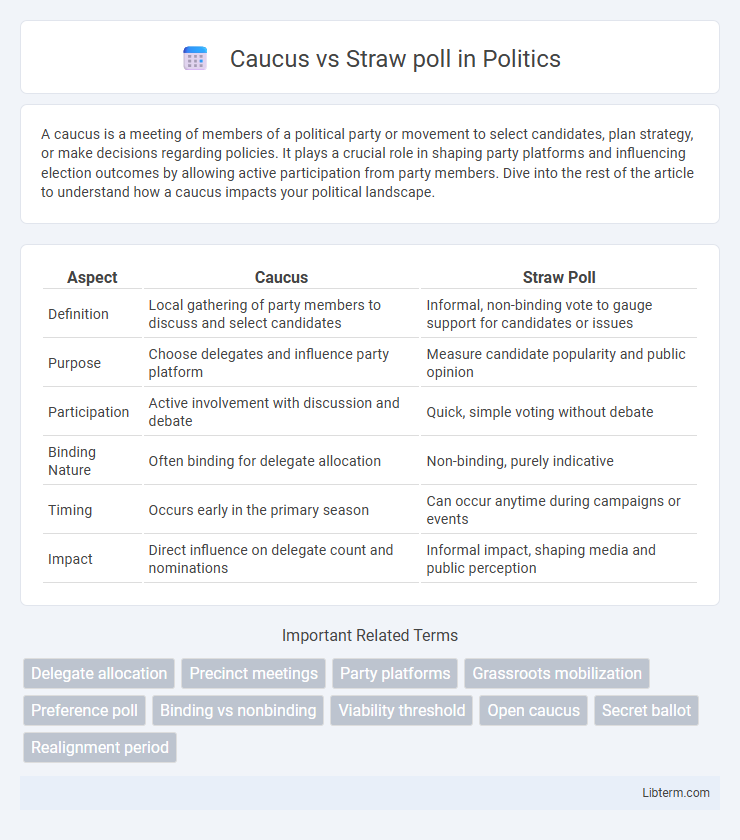A caucus is a meeting of members of a political party or movement to select candidates, plan strategy, or make decisions regarding policies. It plays a crucial role in shaping party platforms and influencing election outcomes by allowing active participation from party members. Dive into the rest of the article to understand how a caucus impacts your political landscape.
Table of Comparison
| Aspect | Caucus | Straw Poll |
|---|---|---|
| Definition | Local gathering of party members to discuss and select candidates | Informal, non-binding vote to gauge support for candidates or issues |
| Purpose | Choose delegates and influence party platform | Measure candidate popularity and public opinion |
| Participation | Active involvement with discussion and debate | Quick, simple voting without debate |
| Binding Nature | Often binding for delegate allocation | Non-binding, purely indicative |
| Timing | Occurs early in the primary season | Can occur anytime during campaigns or events |
| Impact | Direct influence on delegate count and nominations | Informal impact, shaping media and public perception |
Introduction to Caucus and Straw Poll
A caucus is a local gathering where party members discuss and vote on candidates or policies through a series of rounds, emphasizing active participation and community deliberation. Straw polls, on the other hand, are informal, non-binding votes that gauge general support for candidates or issues without detailed discussion. Both methods serve as preliminary indicators of candidate viability but differ significantly in structure and formality.
Definitions: What is a Caucus?
A caucus is a local gathering of registered party members who discuss and vote on candidates or policy issues, often using open dialogue and physical grouping to express preferences. This meeting format allows participants to engage in in-depth conversations and make collective decisions, typically influencing party nominations during election cycles. Unlike secret ballots, caucuses emphasize transparency and community involvement in the political process.
Definitions: What is a Straw Poll?
A straw poll is an informal voting process used to gauge preliminary opinion or support for candidates or issues within a group. It typically involves participants casting non-binding votes to indicate their preferences without official authority or direct impact on the final outcome. Straw polls help organizers understand general sentiment before formal elections or decision-making events like caucuses.
Historical Background of Caucuses
Caucuses originated in the early 19th century as local gatherings where party members physically assembled to discuss and select candidates, reflecting a more participatory democratic process in U.S. elections. This form contrasted with straw polls, which emerged as informal, non-binding votes often used by media outlets to gauge public opinion during presidential primaries. The historical significance of caucuses lies in their role in shaping party platforms and candidate momentum long before the modern primary system became prevalent.
Historical Background of Straw Polls
Straw polls have played a significant role in American political history, dating back to the early 20th century as informal measures of public opinion before primaries were established. These non-binding surveys gained prominence during the 1919 Iowa State Fair, where organizers sought to gauge presidential preferences among attendees. Over time, straw polls evolved into influential indicators that helped candidates assess grassroots support and shape campaign strategies prior to official voting events.
Key Differences Between Caucus and Straw Poll
Caucuses involve local gatherings where participants discuss and vote for candidates, emphasizing community engagement and deliberation, whereas straw polls are informal, non-binding surveys intended to gauge general voter preference quickly. Caucuses typically require active participation at a specific time and location, often influencing delegate selection, while straw polls provide a snapshot of support without direct impact on official outcomes. The key difference lies in caucuses being organized, participatory events central to party nomination processes, contrasting with straw polls' role as simple, unofficial indicators of candidate popularity.
Pros and Cons of Caucuses
Caucuses allow for in-depth discussion and active participant engagement, fostering a more informed and community-driven decision-making process. However, they can be time-consuming, less accessible to individuals with scheduling constraints, and may discourage broader voter participation compared to primaries or straw polls. The public nature of caucuses might also pressure voters, impacting the transparency and privacy of their choices.
Pros and Cons of Straw Polls
Straw polls offer a quick and informal way to gauge voter preferences, providing immediate feedback and high participation due to their simplicity. They lack official status and can be easily influenced by small, unrepresentative groups, leading to skewed or unreliable results. Despite being cost-effective and easy to conduct, straw polls do not provide the detailed deliberation and consensus-building found in caucuses.
Impact on Election Outcomes
Caucuses often lead to higher voter engagement and can influence election outcomes by showcasing grassroots support and strategic alliances within parties, which can sway delegate allocations significantly. Straw polls, while less formal and non-binding, provide early indicators of candidate popularity and momentum, shaping media narratives and donor confidence ahead of official primaries or caucuses. The differing structures and visibility of these voting methods impact campaign strategies and the momentum that candidates build during election cycles.
Conclusion: Choosing Between Caucus and Straw Poll
Selecting between a caucus and a straw poll depends on the desired level of participant engagement and the accuracy of gauging voter preferences. Caucuses facilitate in-depth discussions and real-time voter influence, making them ideal for capturing nuanced opinions in smaller or more active groups. Straw polls offer quick, informal insights suitable for larger populations but may lack the deliberative element that caucuses provide.
Caucus Infographic

 libterm.com
libterm.com